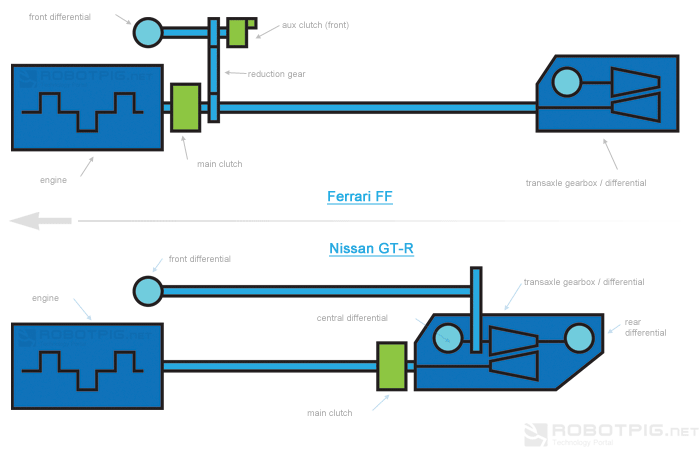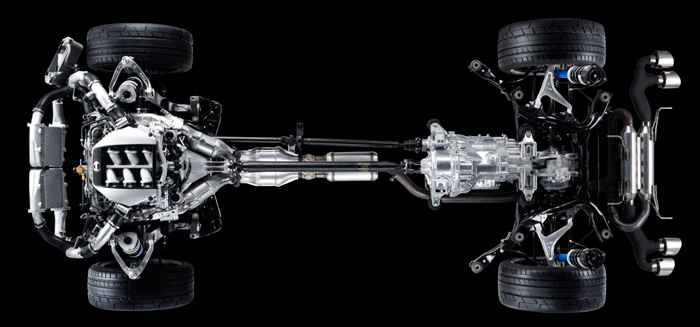| Ferrari FF vs Nissan GT-R |
The only all wheel drive front engine production car with a transaxle today is the Nissan GT-R. It may be much cheaper and not a direct competitor of the FF but from a dynamic point of view and considering their weight distribution and arrangement a comparison should be very interesting.
 (Ferrari FF / Nissan GT-R- photo Ferrari, Nissan) (Ferrari FF / Nissan GT-R- photo Ferrari, Nissan)
The two cars have a lot of similarities. They both have the engine behind the front axle and a dual clutch gearbox in the back. The FF may ultimately be faster and more powerful their performance is in the same order of magnitude.
 (comparative arrangement of the two systems) (comparative arrangement of the two systems)
Dynamically the differences may appear subtle but they are crucial. Balance is probably the most important aspect of a supercar's dynamic behavior. The GT-R has most of its mass placed inside its wheelbase, however the weight is similarly distributed. The relatively small V6 is comparable in size with the rear transaxle where the gearbox is placed inside the wheelbase (the FF has the gearbox behind the rear differential). Stationary the 53% of the GT-R's weight is placed at the front wheels and on acceleration the weight transfer is approaching an even 50-50 front/rear. In order to exploit the traction provided from the tyres the GT-R's transmission has 3 electronically controlled differentials and two propshafts thus it can send a substantial amount of power in the front. During hard acceleration the power is distributed evenly to every tire and when the rear tires operate inside their grip threshold power is mostly send to the rear axle leaving the front tires free to cope with the lateral grip required for steering.
 (In the photo above you can see the complexity of GT-R's system and the mass arrangement - photo Nissan) (In the photo above you can see the complexity of GT-R's system and the mass arrangement - photo Nissan)
The Ferrari FF has a weight distribution that stationary place 47% of the weight at the front and 53% at the rear. Under hard acceleration this ratio becomes even more rear biased. Also the weight isn't as evenly distributed here. The engine is placed further back and it is much heavier while the gearbox is placed behind the rear axle. The result is a car that has a substantially more rear-biased weight distribution and the FF depends more on the rear wheels for providing traction in comparison with the GT-R. As you can see in the graph below, the FF has smaller demands from its all wheel drive system in comparison to the GT-R. Every car is equipped with a system that seems optimized for each vehicles specific concept.
|